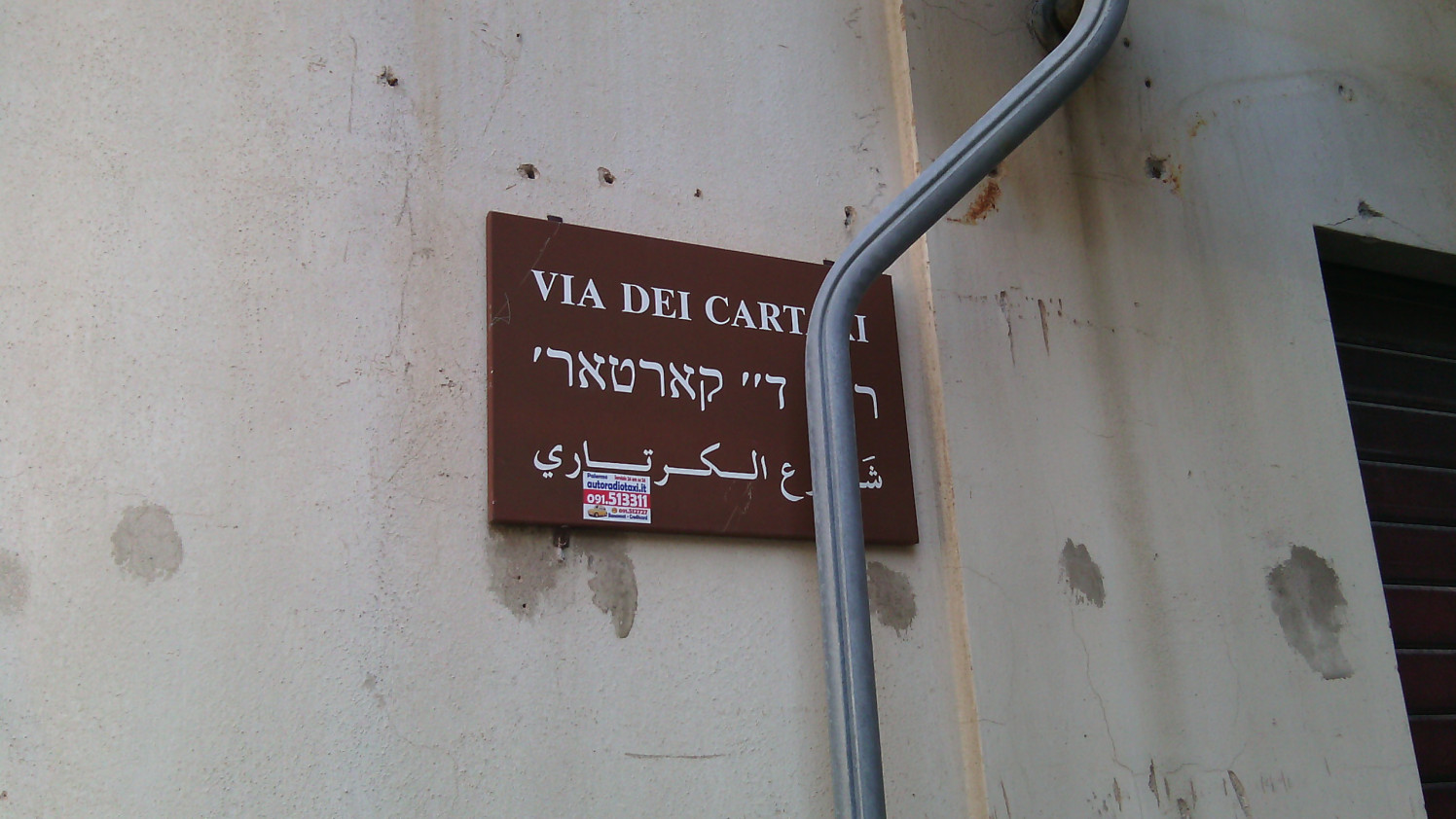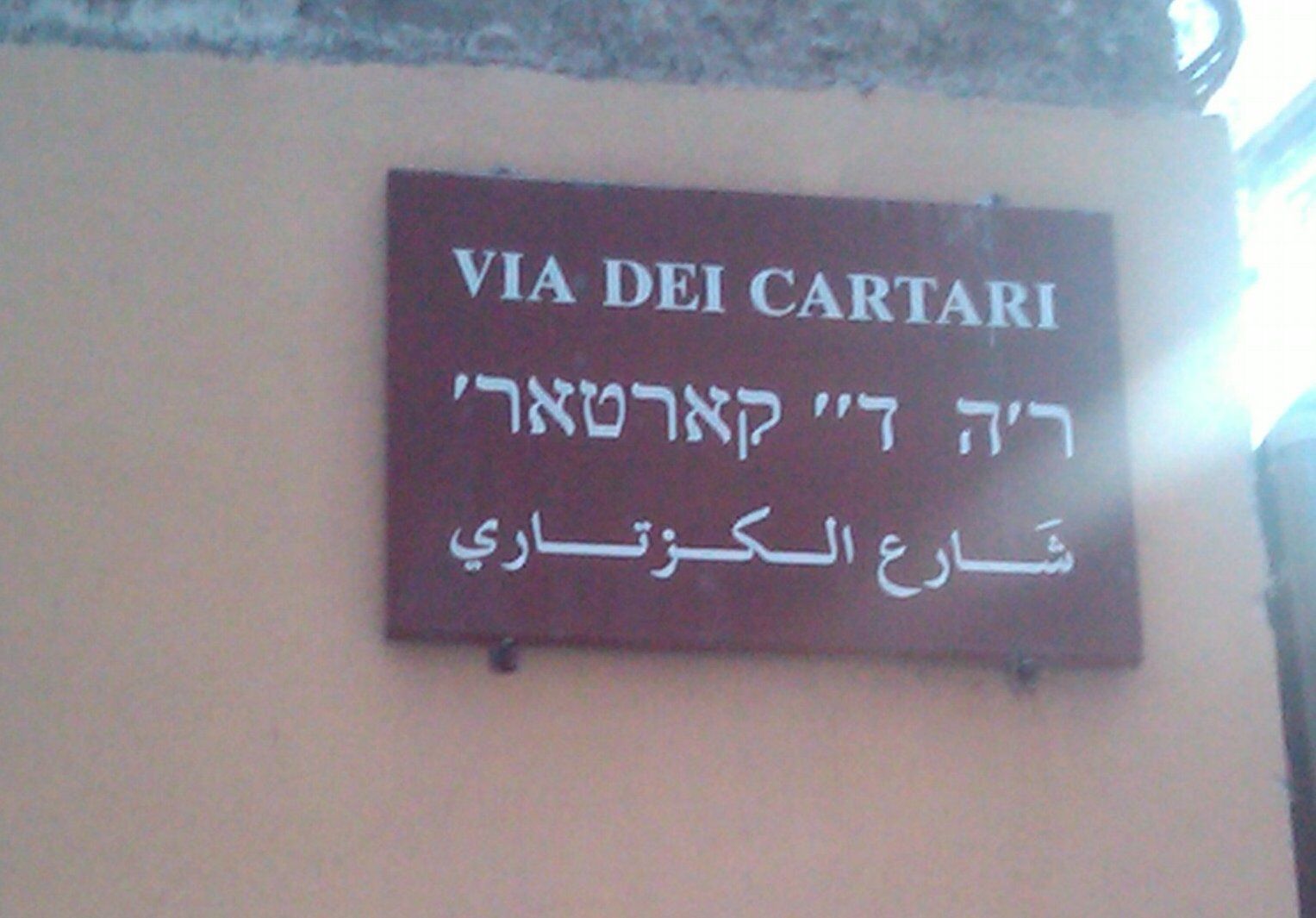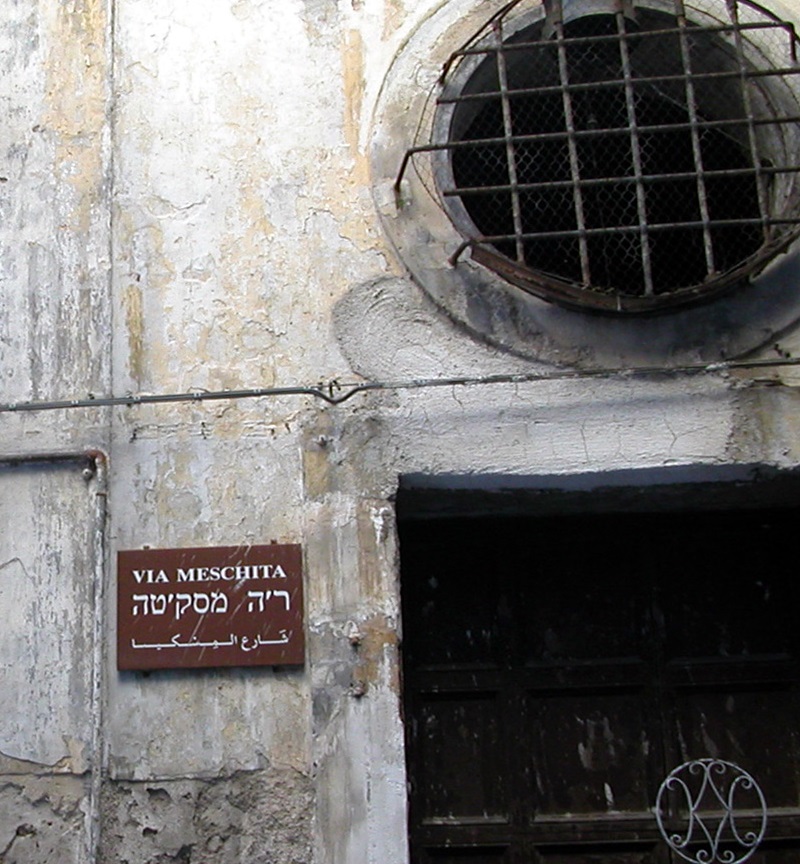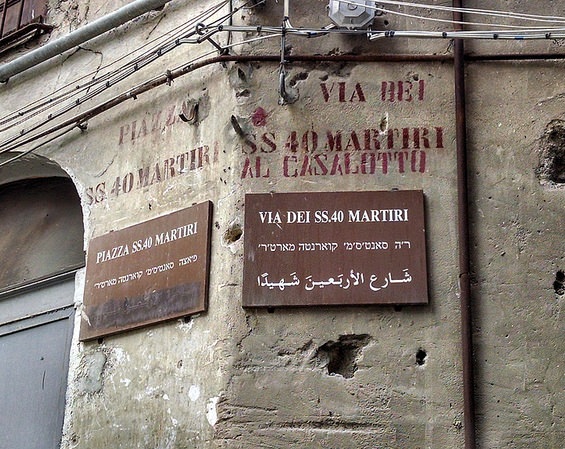Trilingual signs in Sicily
« previous post | next post »
"The Jewish Ghosts of Palermo", a post on The Dangerously Truthful Diary of a Sicilian Housewife, shows this photograph near the beginning:

Caption: Possibly the most important Jewish street in Palermo, the Via dei Cartari was
where all the Jewish scribes drew up any contract needed by the citizens of Palermo.
There's an unobstructed view of the above sign in this photo by "occam", who brought this subject up in alt.usage.english:
The second sign on the "Jewish Ghosts" page is this one:
And here's the third sign:
Jerry Friedman, who called these signs to my attention, comments:
According to the "Jewish Ghosts" page, "cartari" has to do with scribes. I couldn't find it in the Italian-English dictionary at wordreference.com, and Google Translate gives only "papermaking".
"Meschita" seems to be an Italian spelling of "mezquita", the Spanish word for "mosque", maybe left over from the centuries when Spain ruled Sicily. (The Italian word at wordreference is "moschea".) Thus that sign has a Hebrew spelling of an Italian version.
The texts in Hebrew script may be in Judeo-Italian (Italkian). I don't know why apostrophes are used for yods. The Italian "a" seems to be represented by aleph (though one is missing in the word "cuaranta" in the last sign), except at the ends of words, where it's represented by he', as in the many Hebrew words that end in -ah. The first word would be "ria", but that doesn't make sense in Hebrew or Italian or Spanish. Maybe it's an error for "via" that got copied onto all the signs. In general the style of transliteration looks like Yiddish to me.
I don't know Arabic. Will Parsons noted in a.u.e. that "kartaari" looks like "kaaztari" because of a dot.
For historical background, we may quote the beginning of the "Jewish Ghosts" post:
There was a Jewish presence in Sicily for centuries, possibly from before the birth of Jesus. The Jews were the only outsiders who made their homes in Sicily and became part of her population without invading. They simply turned up, fitted in and made themselves indispensable.
The Jews were the literate and educated members of society and they also taught their children all the different languages they knew. This guaranteed them work as interpreters and scribes.
[Hat-tip to Katy Jennison for finding the "Jewish Ghosts" page during the discussion of occam's picture]
Update, 4/3/17: Chips Mackinolty informs us of a "sad footnote" to the story: "In the last days people unknown have spray painted out the non-Italian parts of a number of the trilingual signs." Here is a Facebook message from Palermo's mayor, Leoluca Orlando.



Andy said,
March 17, 2017 @ 10:17 pm
Sicily was ruled by Arab governors until the Normans arrived and Norman Sicilian architecture has Arab features. The Jewish community was even older. This is a wonderful account: http://www.hackwriters.com/JewishSicilyIS.htm
In the Arabic sign for 'cartari', the dot over the 'r' sound may be meant to be a circle, which would have indicated no vowel sound following the 'r' (since the word is Italian, not Arabic). Instead, the dot has turned it into a 'z'.
Y said,
March 17, 2017 @ 11:08 pm
They look recent. The signs look like they were made by the machines used these days for etching gravestones, starting with a computerized design. The letters are obviously computer typefaces.
The sign-maker apparently did not know Hebrew, judging from the confusion of ו and ר (in "ria"), and of י and the apostrophe. I doubt a religious Jew would have written out "Via/Piazza santissimi quaranta martiri".
Kaleberg said,
March 17, 2017 @ 11:20 pm
The use of apostrophes for yods and that reish for vav substitution might be a result of the original Hebrew being in manual print which lacks the familiar serifs. A yod really does look like an apostrophe with a bit of extra curl to it. A reish really does look like a vav with a slightly longer horizontal arm. I'll call it artistic license. Those look like fairly new signs, so I guess they could have Googled, but ….
I've always been amused by the rendering of non-Hebrew using Hebrew letters. Berenice Abott documented a lot of it in her 1930s photos of New York City. At first the signs seem inscrutible.Then you sound them out letter by letter and get familiar English words. The convention with English in NYC was using an ayin as the default silent letter, not a hey. It looks weird at the end of a word.
Chips Mackinolty said,
March 17, 2017 @ 11:30 pm
Whatever inaccuracies that might exist in the street sign translations, the work was undertaken by Palermitani historians and linguists who wished to remind their countrymen of the history they share with Arabs and Jewish people, as well as marking shameful times under the Spaniards of the expulsion of Arabs and Jews from an island they had lived in for many centuries. On 12 January this year the Archbishop of Palermo handed back part of the monastery of St. Nicolo Tolentino, which was built atop the ruins of the Great Synagogue of Palermo as the first synagogue in Palermo in over 520 years. That date marks the date when Queen Isabella ordered the expulsion of Jewish people (or their conversion to Christianity).
Many Sicilians today have family names, or place names, derived from Arabic and Jewish names (or in the latter case, their "conversion" names). Both groups prospered under Norman rule, and in the 12th century Palermo was regarded as one of the great seats of learning, art and architecture thanks to these groups.
There is a slow re-building of both Jewish and Muslim people in Palermo. The mayor, Leoluca Orlando, for example, annually attends the Eid celebration on the shores of the harbour. A few weeks later, on 14 July, he plays a major role in the festino for Santa Rosalia [Rusulia in dialect], the (Christian) patron saint of the city.
As an island, Sicily has been invaded by the Phoenicians, Greeks, Romans, Arabs, Normans, French, Spanish, Papal states, and more recently the Americans. It is a series of communities that remembers its historic and linguistic heritages.
tangent said,
March 18, 2017 @ 1:26 am
Andy, that's a fascinating bit of history — thanks for the link.
Tom S. Fox said,
March 18, 2017 @ 6:31 am
Why do people always act as if wordreference is the only dictionary on the Internet?
https://en.wiktionary.org/wiki/cartario
http://en.bab.la/dictionary/italian-english/cartario
And the Italian word for “forty” is “quaranta,” not “cuaranta.”
Chips Mackinolty said,
March 18, 2017 @ 6:58 am
@Jerry Friedman, papermaking is correct, and refers to a time when that was the major economic activity on that street: such signposting, as it were, is very common in the old centre of Palermo.
@Y, there is no good reason why a Hebrew scholar would not translate that name of a street, whether or not in her/his religious background sainted martyrs existed or not.
Y said,
March 18, 2017 @ 8:40 am
Chips: Sure, I was just noting that a traditional Jewish community would be unlikely to use that word.
Picky said,
March 18, 2017 @ 9:32 am
@Chips Mackinolty: invaded more recently by the Americans/British/Canadians, I think.
Yuval said,
March 18, 2017 @ 9:47 am
I subscribe to the orthographic vav/reish and yod/apostrophe confusion theory. A little more farfetched one might be that Via was to be translated to Rehov, abbreviated רח' (w/apostrophe), then some creative mutation and ח-ה substitution.
Adding to the mystery is that the Hebrew is transliterated but the Arabic is translated, both in shari' fot street and in most of the other words (like shahid for martyr, but nothing for Santissimi…).
Jerry Friedman said,
March 18, 2017 @ 10:47 am
Tom S. Fox: I didn't use only wordreference, but I get your point. Thanks for pointing me to the other dictionaries and for correcting my Spanish-style spelling of "quaranta". So "Via dei Cartari" is "Street of the collections of documents"?
To judge by what Google Translate tells me about this article from la Repubblica.it, cartari in Palermo were makers of playing cards.
(I notice that there's also a Via dei Cartari in Roma, ending at the Piazza Navona. Also that there was (is?) a prominent Cartari family in Rome.)
@Chips Mackinolty: Thanks for the interesting comment on the reason for the signs. I'd guessed they were intended at least as much for tourists interested in Jewish and Islamic (Judaic and Muslim?) history.
Y and Yuval: Peter T. Daniels also suggested the vav-reish theory at alt.usage.english. My reason for doubting it was that vav was used for "u" in "quaranta". However, at the hackwriters page that Andy linked to above, "vicolo" has reish for "v" and "vav" for "o". So maybe the transliterator used diacritical marks to distinguish "v", "o", and "u", and whoever printed the signs just punted on them. But why read vav as reish only at the beginnings of words?
That site also makes the interesting suggestion that the Meschita, or mosque, might actually have meant the Great Synagogue.
I still think it's weird to use aleph for "a" at the beginning or middle of a word and he' at the end, especially for Italian words that end in unstressed final "a", since most (all?) Hebrew words ending in -ah have stress on that final syllable.
Jerry Friedman said,
March 18, 2017 @ 11:00 am
By the way, here's a sign for Via Divisi with a vav for the "v" in "Divisi", and here's one for Piazza Ponticello with a real yod for the "e" (unlike the sign for Via Meschita where the "e" was just omitted and the sign for Via dei Cartari where "ei" was a double apostrophe).
Rodger C said,
March 18, 2017 @ 11:31 am
The convention with English in NYC was using an ayin as the default silent letter, not a hey. It looks weird at the end of a word.
Inspired by Yiddish?
ella said,
March 18, 2017 @ 3:38 pm
Thank-you, Andy, that was super interesting.
Chips Mackinolty said,
March 18, 2017 @ 5:32 pm
@Jerry Friedman. I have checked with local historian Francesco Pusateri–it is indeed a maker of playing cards: the manufacture of paper per se needed more amounts of water and was therefore located along the Oreto River, some distance away.
@Jerry Friedman, there is some evidence that via “Meschita” or “Moschita” was the site of a mosque–there were up to 300 mosques in the pre-Spanish Palermo! (again courtesy Francesco Pusateri)
Jerry Friedman said,
March 18, 2017 @ 7:20 pm
Chips Mackinolty: Thanks, that's a better source than I was hoping to get!
J.W. Brewer said,
March 19, 2017 @ 3:23 pm
A further complication is that if you go far enough back into medieval Palermo the local Jews would perhaps have been more likely for everyday purposes to use Hebrew script to write the local dialect of Judeo-Arabic than to write Judeo-Italian. Obviously whether something like a street name would have been translated/calqued versus just transliterated (out of whatever would have been considered the default/normal/unmarked language for that sort of toponym in that place and time) is hard to say.
Chips Mackinolty said,
March 19, 2017 @ 5:57 pm
@ J.W. Brewer
My instinct in this further complication is that place names, at least, would be transliterated, unless it was a word shared between Hebrew and Arabic. The Kalsa district, from the Arabic Al-Khalisa, might be a case in point, though I know no Hebrew to compare. In Arabic, Al-Khalisa, means "the purest", so my guess would be a transliteration. Historically, the area has been and continues to be called la Kalsa, with no attempt to translate into "più puro".
The letter "K" doesn't exist in the Italian or Sicilian orthographies, with the exception of imported words. In the case of la Kalsa, the importation happened over 1000 years ago!
Travis said,
March 19, 2017 @ 9:15 pm
Regarding the use of ayin instead of hey at the end of a word, I am no expert, but I believe that's quite common in Judeo-Spanish (Ladino), which is what Jews in Italy likely would have known and used as their creole language (if that's the right word), whereas the spelling conventions are different in Yiddish…
Chips Mackinolty said,
March 20, 2017 @ 7:55 am
It's unclear whether Ladino was spoken to a great extent in Sicily, if at all, pre 1492. There were significant Jewish populations in Sicily dating well before Christ, and Hebrew words, rendered in the Greek alphabet have been found on amulets and carved inscriptions in Sicily (concevably a consequence or remnant of the period when the east of Sicily, was regarded as Magna Graecia, though that takes us back to the 8th and 7th centuries BC). The major diaspora after 70AD added to the Jewish population of Sicily, as well as Spain (hence Ladino based on Old Spanish). Under the Normans, Hebrew texts and their scholars were extensively utilised, especially in legal matters.As traders for many centuries, Jewish people were also used for their knowledge of Mediterranean languages–and may well have had Ladino as part of their linguistic armoury, though from my reading Ladino largely developed post the 1492 expulsion–happy to be corrected on that.
Jerry Friedman said,
March 20, 2017 @ 12:05 pm
Travis: You mean the use of hey rather than aleph for "a" at the end of a word? According to ,a href="https://en.wikipedia.org/wiki/Judaeo-Spanish#Orthography">Wikipedia, that is characteristic of Ladino, so thanks for mentioning it.
I said,
March 21, 2017 @ 5:46 am
I assume ר׳ה is a mistake for רח׳ and that it is just meant to be the standard abbreviation for רחוב (street).
Jerry Friedman said,
March 23, 2017 @ 2:13 pm
I: That sounds reasonable based on the pictures above, but if you go to the hackwriters site linked in the first comment, you'll see a sign for "Vicolo Meschita" that uses a ר as the first letter of "Vicolo".